Comprehensive Analysis of Human Resource Management at Wilson Brothers
VerifiedAdded on 2023/06/08
|10
|2691
|418
Report
AI Summary
This report provides a comprehensive analysis of the human resource management (HRM) practices at Wilson Brothers, a Canadian firm. It examines the company's organizational structure, which is identified as a line structure with a rigid hierarchy, and suggests a functional or line and staff structure for better adaptability. The report also delves into job design, highlighting the humanistic approach and suggesting the Job Characteristics Model to enhance employee satisfaction and productivity. Internal communications, currently email-based, are critiqued, and regular meetings are recommended to avoid miscommunication. The report addresses equity concerns, suggesting transparency in promotion criteria and paychecks. Organizational culture is analyzed as hierarchical, with alternative clan or adhocracy cultures proposed. The company's organizational change strategy is evaluated, emphasizing the need for effective communication and the application of Lewin's change management model. Teamwork, conflict resolution, and leadership styles (autocratic vs. democratic/situational) are discussed, along with the use of power, influence, and motivation strategies, advocating for a reward power system to increase employee engagement and performance. The report concludes with a discussion of conflict resolution and team dynamics, offering insights into improving overall HRM effectiveness.
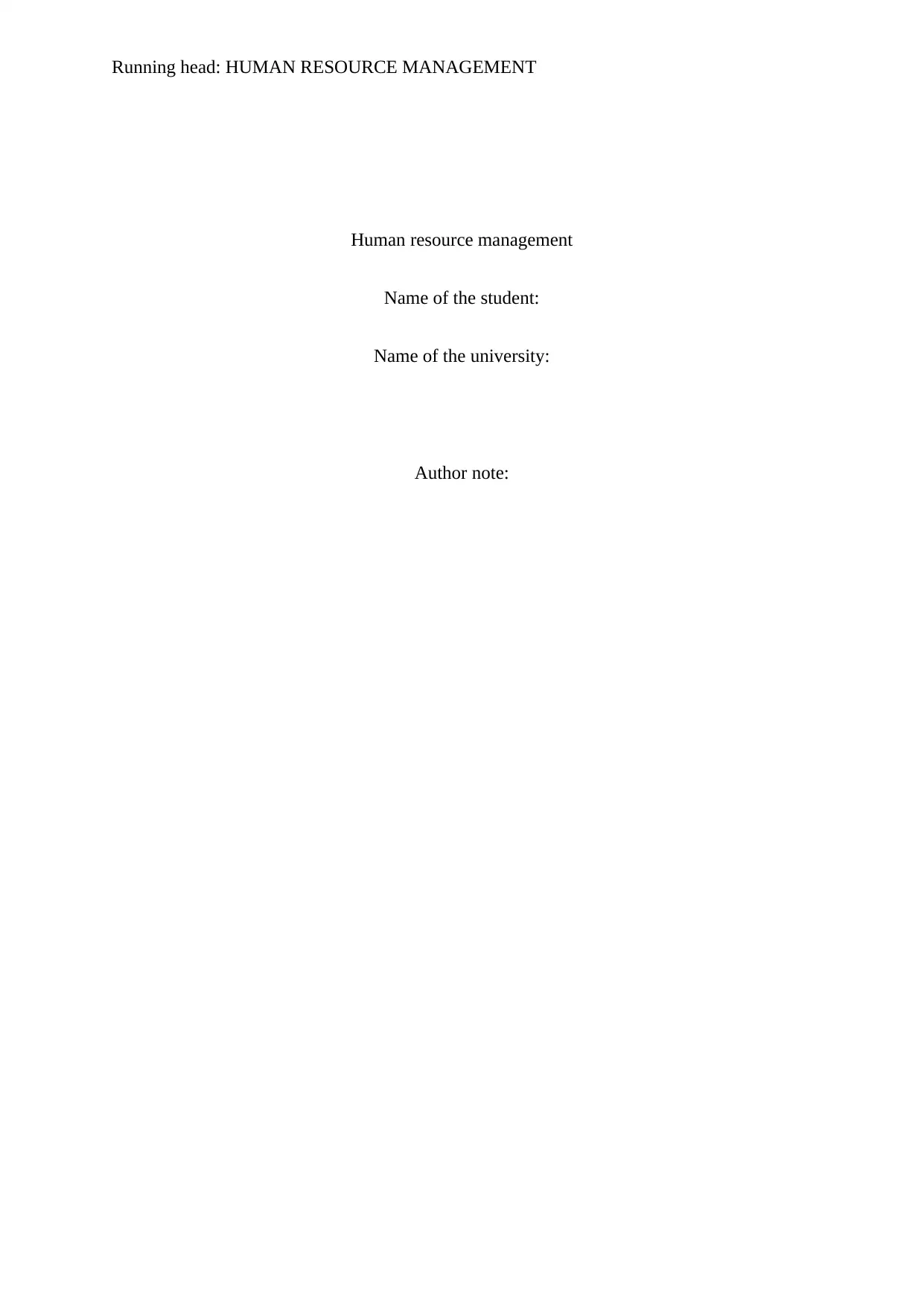
Running head: HUMAN RESOURCE MANAGEMENT
Human resource management
Name of the student:
Name of the university:
Author note:
Human resource management
Name of the student:
Name of the university:
Author note:
Paraphrase This Document
Need a fresh take? Get an instant paraphrase of this document with our AI Paraphraser
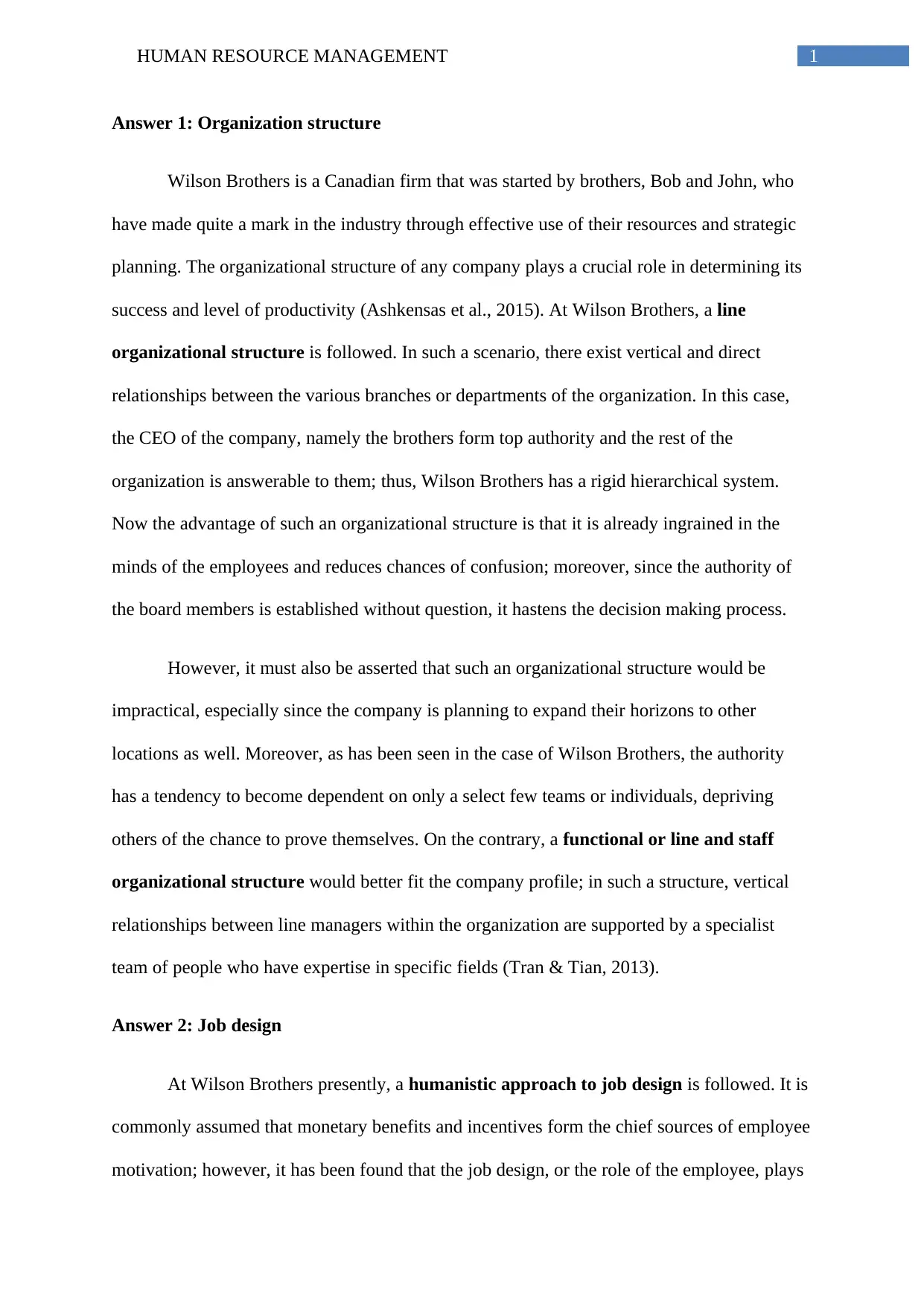
1HUMAN RESOURCE MANAGEMENT
Answer 1: Organization structure
Wilson Brothers is a Canadian firm that was started by brothers, Bob and John, who
have made quite a mark in the industry through effective use of their resources and strategic
planning. The organizational structure of any company plays a crucial role in determining its
success and level of productivity (Ashkensas et al., 2015). At Wilson Brothers, a line
organizational structure is followed. In such a scenario, there exist vertical and direct
relationships between the various branches or departments of the organization. In this case,
the CEO of the company, namely the brothers form top authority and the rest of the
organization is answerable to them; thus, Wilson Brothers has a rigid hierarchical system.
Now the advantage of such an organizational structure is that it is already ingrained in the
minds of the employees and reduces chances of confusion; moreover, since the authority of
the board members is established without question, it hastens the decision making process.
However, it must also be asserted that such an organizational structure would be
impractical, especially since the company is planning to expand their horizons to other
locations as well. Moreover, as has been seen in the case of Wilson Brothers, the authority
has a tendency to become dependent on only a select few teams or individuals, depriving
others of the chance to prove themselves. On the contrary, a functional or line and staff
organizational structure would better fit the company profile; in such a structure, vertical
relationships between line managers within the organization are supported by a specialist
team of people who have expertise in specific fields (Tran & Tian, 2013).
Answer 2: Job design
At Wilson Brothers presently, a humanistic approach to job design is followed. It is
commonly assumed that monetary benefits and incentives form the chief sources of employee
motivation; however, it has been found that the job design, or the role of the employee, plays
Answer 1: Organization structure
Wilson Brothers is a Canadian firm that was started by brothers, Bob and John, who
have made quite a mark in the industry through effective use of their resources and strategic
planning. The organizational structure of any company plays a crucial role in determining its
success and level of productivity (Ashkensas et al., 2015). At Wilson Brothers, a line
organizational structure is followed. In such a scenario, there exist vertical and direct
relationships between the various branches or departments of the organization. In this case,
the CEO of the company, namely the brothers form top authority and the rest of the
organization is answerable to them; thus, Wilson Brothers has a rigid hierarchical system.
Now the advantage of such an organizational structure is that it is already ingrained in the
minds of the employees and reduces chances of confusion; moreover, since the authority of
the board members is established without question, it hastens the decision making process.
However, it must also be asserted that such an organizational structure would be
impractical, especially since the company is planning to expand their horizons to other
locations as well. Moreover, as has been seen in the case of Wilson Brothers, the authority
has a tendency to become dependent on only a select few teams or individuals, depriving
others of the chance to prove themselves. On the contrary, a functional or line and staff
organizational structure would better fit the company profile; in such a structure, vertical
relationships between line managers within the organization are supported by a specialist
team of people who have expertise in specific fields (Tran & Tian, 2013).
Answer 2: Job design
At Wilson Brothers presently, a humanistic approach to job design is followed. It is
commonly assumed that monetary benefits and incentives form the chief sources of employee
motivation; however, it has been found that the job design, or the role of the employee, plays
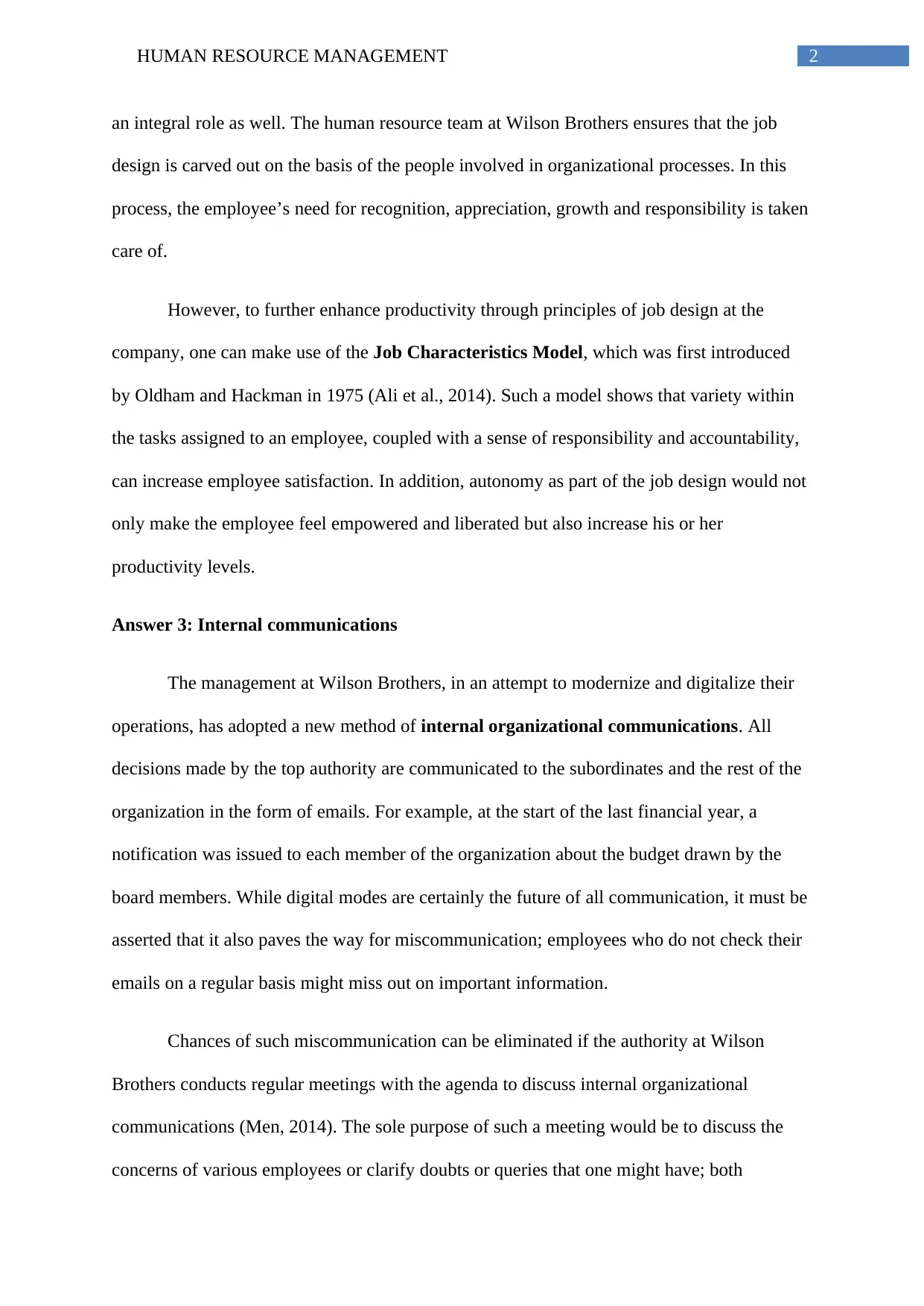
2HUMAN RESOURCE MANAGEMENT
an integral role as well. The human resource team at Wilson Brothers ensures that the job
design is carved out on the basis of the people involved in organizational processes. In this
process, the employee’s need for recognition, appreciation, growth and responsibility is taken
care of.
However, to further enhance productivity through principles of job design at the
company, one can make use of the Job Characteristics Model, which was first introduced
by Oldham and Hackman in 1975 (Ali et al., 2014). Such a model shows that variety within
the tasks assigned to an employee, coupled with a sense of responsibility and accountability,
can increase employee satisfaction. In addition, autonomy as part of the job design would not
only make the employee feel empowered and liberated but also increase his or her
productivity levels.
Answer 3: Internal communications
The management at Wilson Brothers, in an attempt to modernize and digitalize their
operations, has adopted a new method of internal organizational communications. All
decisions made by the top authority are communicated to the subordinates and the rest of the
organization in the form of emails. For example, at the start of the last financial year, a
notification was issued to each member of the organization about the budget drawn by the
board members. While digital modes are certainly the future of all communication, it must be
asserted that it also paves the way for miscommunication; employees who do not check their
emails on a regular basis might miss out on important information.
Chances of such miscommunication can be eliminated if the authority at Wilson
Brothers conducts regular meetings with the agenda to discuss internal organizational
communications (Men, 2014). The sole purpose of such a meeting would be to discuss the
concerns of various employees or clarify doubts or queries that one might have; both
an integral role as well. The human resource team at Wilson Brothers ensures that the job
design is carved out on the basis of the people involved in organizational processes. In this
process, the employee’s need for recognition, appreciation, growth and responsibility is taken
care of.
However, to further enhance productivity through principles of job design at the
company, one can make use of the Job Characteristics Model, which was first introduced
by Oldham and Hackman in 1975 (Ali et al., 2014). Such a model shows that variety within
the tasks assigned to an employee, coupled with a sense of responsibility and accountability,
can increase employee satisfaction. In addition, autonomy as part of the job design would not
only make the employee feel empowered and liberated but also increase his or her
productivity levels.
Answer 3: Internal communications
The management at Wilson Brothers, in an attempt to modernize and digitalize their
operations, has adopted a new method of internal organizational communications. All
decisions made by the top authority are communicated to the subordinates and the rest of the
organization in the form of emails. For example, at the start of the last financial year, a
notification was issued to each member of the organization about the budget drawn by the
board members. While digital modes are certainly the future of all communication, it must be
asserted that it also paves the way for miscommunication; employees who do not check their
emails on a regular basis might miss out on important information.
Chances of such miscommunication can be eliminated if the authority at Wilson
Brothers conducts regular meetings with the agenda to discuss internal organizational
communications (Men, 2014). The sole purpose of such a meeting would be to discuss the
concerns of various employees or clarify doubts or queries that one might have; both
⊘ This is a preview!⊘
Do you want full access?
Subscribe today to unlock all pages.

Trusted by 1+ million students worldwide
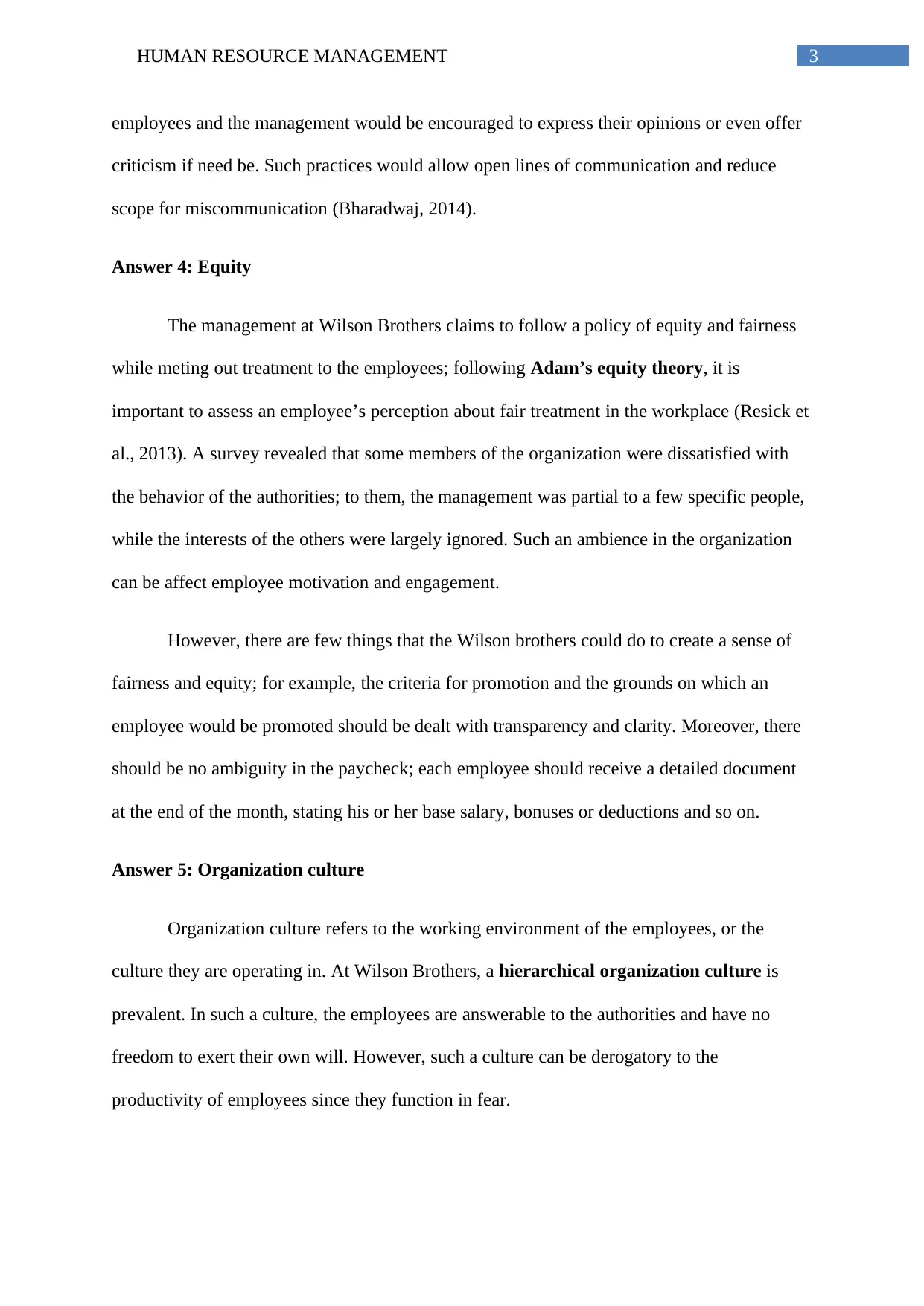
3HUMAN RESOURCE MANAGEMENT
employees and the management would be encouraged to express their opinions or even offer
criticism if need be. Such practices would allow open lines of communication and reduce
scope for miscommunication (Bharadwaj, 2014).
Answer 4: Equity
The management at Wilson Brothers claims to follow a policy of equity and fairness
while meting out treatment to the employees; following Adam’s equity theory, it is
important to assess an employee’s perception about fair treatment in the workplace (Resick et
al., 2013). A survey revealed that some members of the organization were dissatisfied with
the behavior of the authorities; to them, the management was partial to a few specific people,
while the interests of the others were largely ignored. Such an ambience in the organization
can be affect employee motivation and engagement.
However, there are few things that the Wilson brothers could do to create a sense of
fairness and equity; for example, the criteria for promotion and the grounds on which an
employee would be promoted should be dealt with transparency and clarity. Moreover, there
should be no ambiguity in the paycheck; each employee should receive a detailed document
at the end of the month, stating his or her base salary, bonuses or deductions and so on.
Answer 5: Organization culture
Organization culture refers to the working environment of the employees, or the
culture they are operating in. At Wilson Brothers, a hierarchical organization culture is
prevalent. In such a culture, the employees are answerable to the authorities and have no
freedom to exert their own will. However, such a culture can be derogatory to the
productivity of employees since they function in fear.
employees and the management would be encouraged to express their opinions or even offer
criticism if need be. Such practices would allow open lines of communication and reduce
scope for miscommunication (Bharadwaj, 2014).
Answer 4: Equity
The management at Wilson Brothers claims to follow a policy of equity and fairness
while meting out treatment to the employees; following Adam’s equity theory, it is
important to assess an employee’s perception about fair treatment in the workplace (Resick et
al., 2013). A survey revealed that some members of the organization were dissatisfied with
the behavior of the authorities; to them, the management was partial to a few specific people,
while the interests of the others were largely ignored. Such an ambience in the organization
can be affect employee motivation and engagement.
However, there are few things that the Wilson brothers could do to create a sense of
fairness and equity; for example, the criteria for promotion and the grounds on which an
employee would be promoted should be dealt with transparency and clarity. Moreover, there
should be no ambiguity in the paycheck; each employee should receive a detailed document
at the end of the month, stating his or her base salary, bonuses or deductions and so on.
Answer 5: Organization culture
Organization culture refers to the working environment of the employees, or the
culture they are operating in. At Wilson Brothers, a hierarchical organization culture is
prevalent. In such a culture, the employees are answerable to the authorities and have no
freedom to exert their own will. However, such a culture can be derogatory to the
productivity of employees since they function in fear.
Paraphrase This Document
Need a fresh take? Get an instant paraphrase of this document with our AI Paraphraser
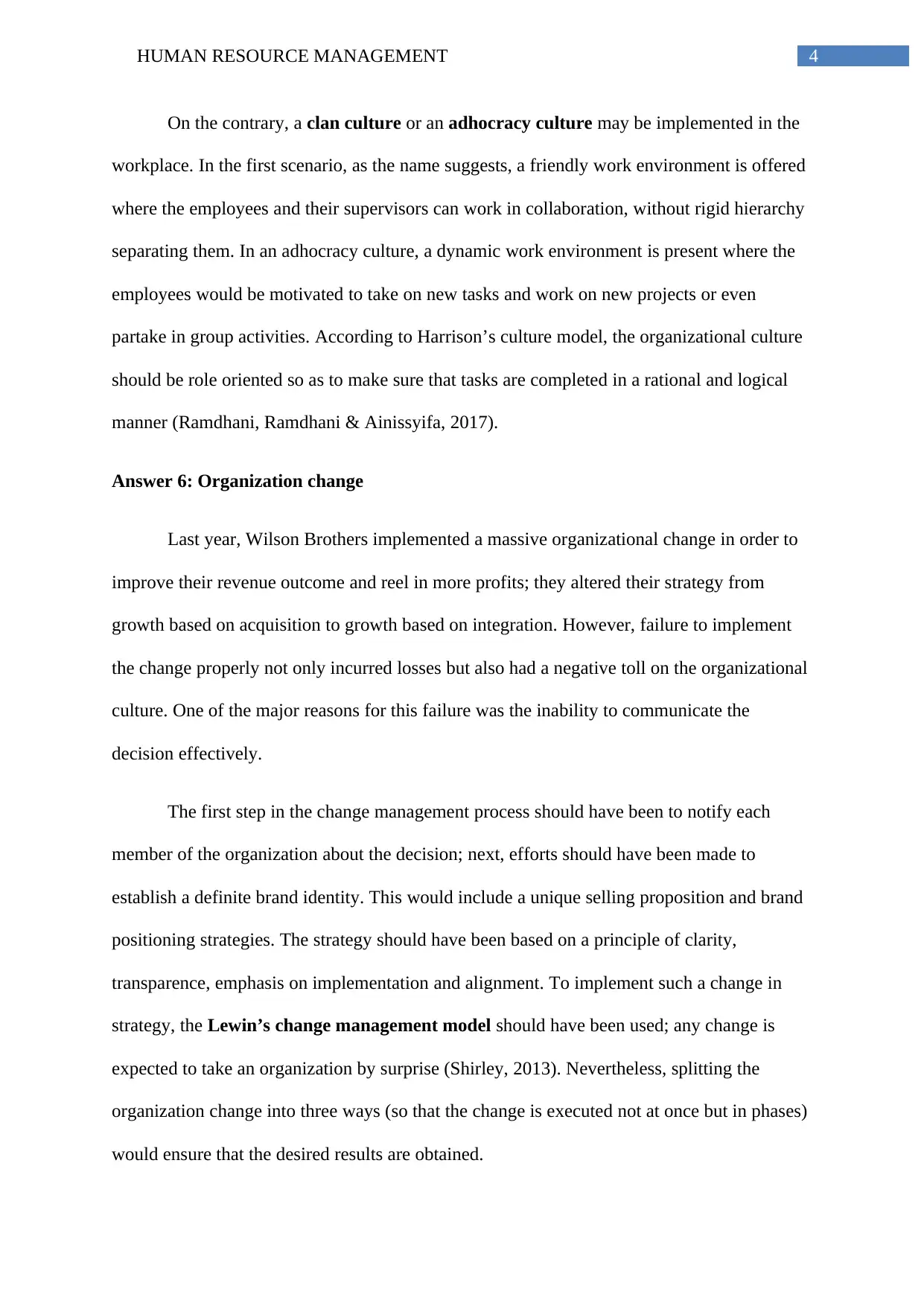
4HUMAN RESOURCE MANAGEMENT
On the contrary, a clan culture or an adhocracy culture may be implemented in the
workplace. In the first scenario, as the name suggests, a friendly work environment is offered
where the employees and their supervisors can work in collaboration, without rigid hierarchy
separating them. In an adhocracy culture, a dynamic work environment is present where the
employees would be motivated to take on new tasks and work on new projects or even
partake in group activities. According to Harrison’s culture model, the organizational culture
should be role oriented so as to make sure that tasks are completed in a rational and logical
manner (Ramdhani, Ramdhani & Ainissyifa, 2017).
Answer 6: Organization change
Last year, Wilson Brothers implemented a massive organizational change in order to
improve their revenue outcome and reel in more profits; they altered their strategy from
growth based on acquisition to growth based on integration. However, failure to implement
the change properly not only incurred losses but also had a negative toll on the organizational
culture. One of the major reasons for this failure was the inability to communicate the
decision effectively.
The first step in the change management process should have been to notify each
member of the organization about the decision; next, efforts should have been made to
establish a definite brand identity. This would include a unique selling proposition and brand
positioning strategies. The strategy should have been based on a principle of clarity,
transparence, emphasis on implementation and alignment. To implement such a change in
strategy, the Lewin’s change management model should have been used; any change is
expected to take an organization by surprise (Shirley, 2013). Nevertheless, splitting the
organization change into three ways (so that the change is executed not at once but in phases)
would ensure that the desired results are obtained.
On the contrary, a clan culture or an adhocracy culture may be implemented in the
workplace. In the first scenario, as the name suggests, a friendly work environment is offered
where the employees and their supervisors can work in collaboration, without rigid hierarchy
separating them. In an adhocracy culture, a dynamic work environment is present where the
employees would be motivated to take on new tasks and work on new projects or even
partake in group activities. According to Harrison’s culture model, the organizational culture
should be role oriented so as to make sure that tasks are completed in a rational and logical
manner (Ramdhani, Ramdhani & Ainissyifa, 2017).
Answer 6: Organization change
Last year, Wilson Brothers implemented a massive organizational change in order to
improve their revenue outcome and reel in more profits; they altered their strategy from
growth based on acquisition to growth based on integration. However, failure to implement
the change properly not only incurred losses but also had a negative toll on the organizational
culture. One of the major reasons for this failure was the inability to communicate the
decision effectively.
The first step in the change management process should have been to notify each
member of the organization about the decision; next, efforts should have been made to
establish a definite brand identity. This would include a unique selling proposition and brand
positioning strategies. The strategy should have been based on a principle of clarity,
transparence, emphasis on implementation and alignment. To implement such a change in
strategy, the Lewin’s change management model should have been used; any change is
expected to take an organization by surprise (Shirley, 2013). Nevertheless, splitting the
organization change into three ways (so that the change is executed not at once but in phases)
would ensure that the desired results are obtained.
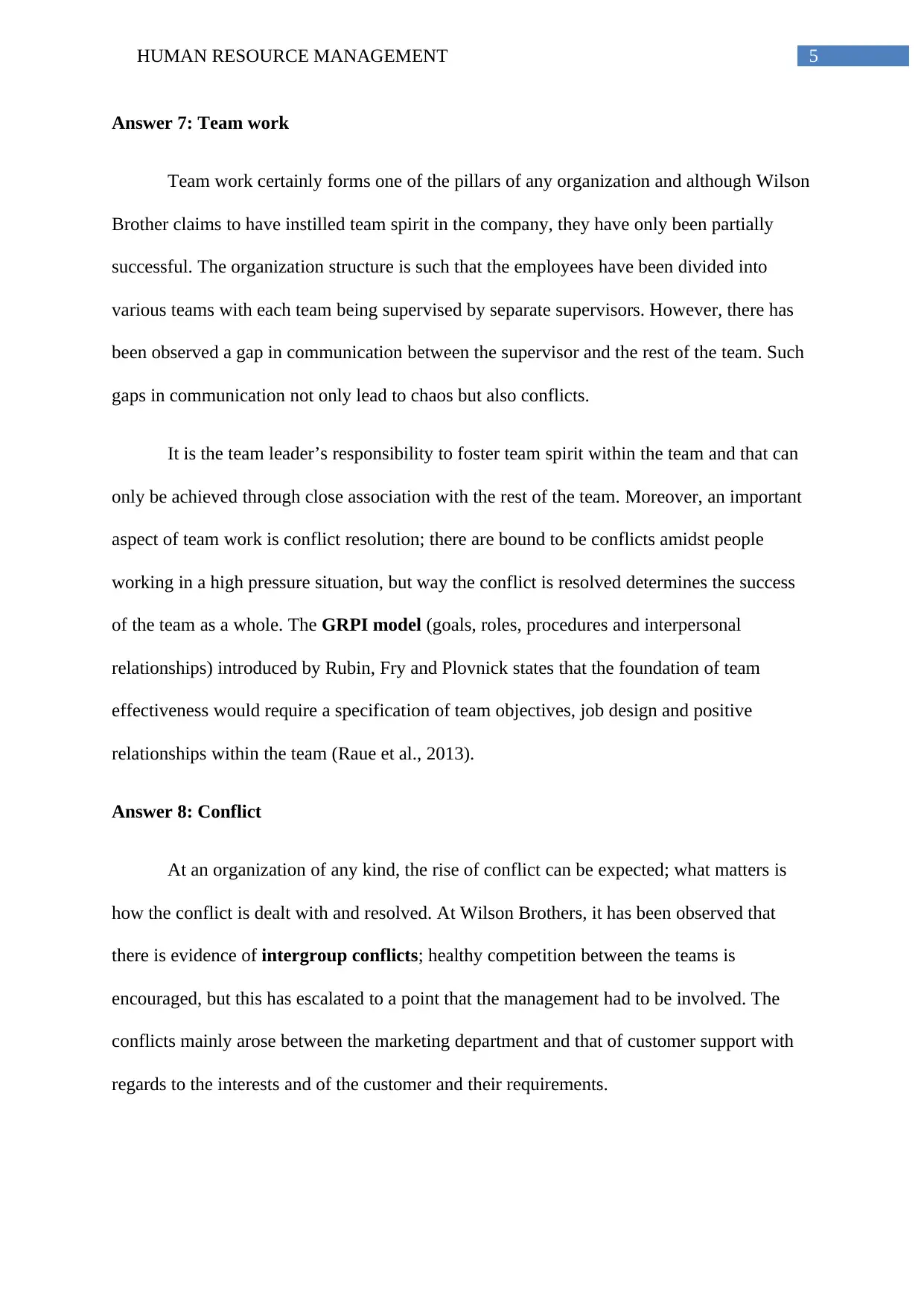
5HUMAN RESOURCE MANAGEMENT
Answer 7: Team work
Team work certainly forms one of the pillars of any organization and although Wilson
Brother claims to have instilled team spirit in the company, they have only been partially
successful. The organization structure is such that the employees have been divided into
various teams with each team being supervised by separate supervisors. However, there has
been observed a gap in communication between the supervisor and the rest of the team. Such
gaps in communication not only lead to chaos but also conflicts.
It is the team leader’s responsibility to foster team spirit within the team and that can
only be achieved through close association with the rest of the team. Moreover, an important
aspect of team work is conflict resolution; there are bound to be conflicts amidst people
working in a high pressure situation, but way the conflict is resolved determines the success
of the team as a whole. The GRPI model (goals, roles, procedures and interpersonal
relationships) introduced by Rubin, Fry and Plovnick states that the foundation of team
effectiveness would require a specification of team objectives, job design and positive
relationships within the team (Raue et al., 2013).
Answer 8: Conflict
At an organization of any kind, the rise of conflict can be expected; what matters is
how the conflict is dealt with and resolved. At Wilson Brothers, it has been observed that
there is evidence of intergroup conflicts; healthy competition between the teams is
encouraged, but this has escalated to a point that the management had to be involved. The
conflicts mainly arose between the marketing department and that of customer support with
regards to the interests and of the customer and their requirements.
Answer 7: Team work
Team work certainly forms one of the pillars of any organization and although Wilson
Brother claims to have instilled team spirit in the company, they have only been partially
successful. The organization structure is such that the employees have been divided into
various teams with each team being supervised by separate supervisors. However, there has
been observed a gap in communication between the supervisor and the rest of the team. Such
gaps in communication not only lead to chaos but also conflicts.
It is the team leader’s responsibility to foster team spirit within the team and that can
only be achieved through close association with the rest of the team. Moreover, an important
aspect of team work is conflict resolution; there are bound to be conflicts amidst people
working in a high pressure situation, but way the conflict is resolved determines the success
of the team as a whole. The GRPI model (goals, roles, procedures and interpersonal
relationships) introduced by Rubin, Fry and Plovnick states that the foundation of team
effectiveness would require a specification of team objectives, job design and positive
relationships within the team (Raue et al., 2013).
Answer 8: Conflict
At an organization of any kind, the rise of conflict can be expected; what matters is
how the conflict is dealt with and resolved. At Wilson Brothers, it has been observed that
there is evidence of intergroup conflicts; healthy competition between the teams is
encouraged, but this has escalated to a point that the management had to be involved. The
conflicts mainly arose between the marketing department and that of customer support with
regards to the interests and of the customer and their requirements.
⊘ This is a preview!⊘
Do you want full access?
Subscribe today to unlock all pages.

Trusted by 1+ million students worldwide
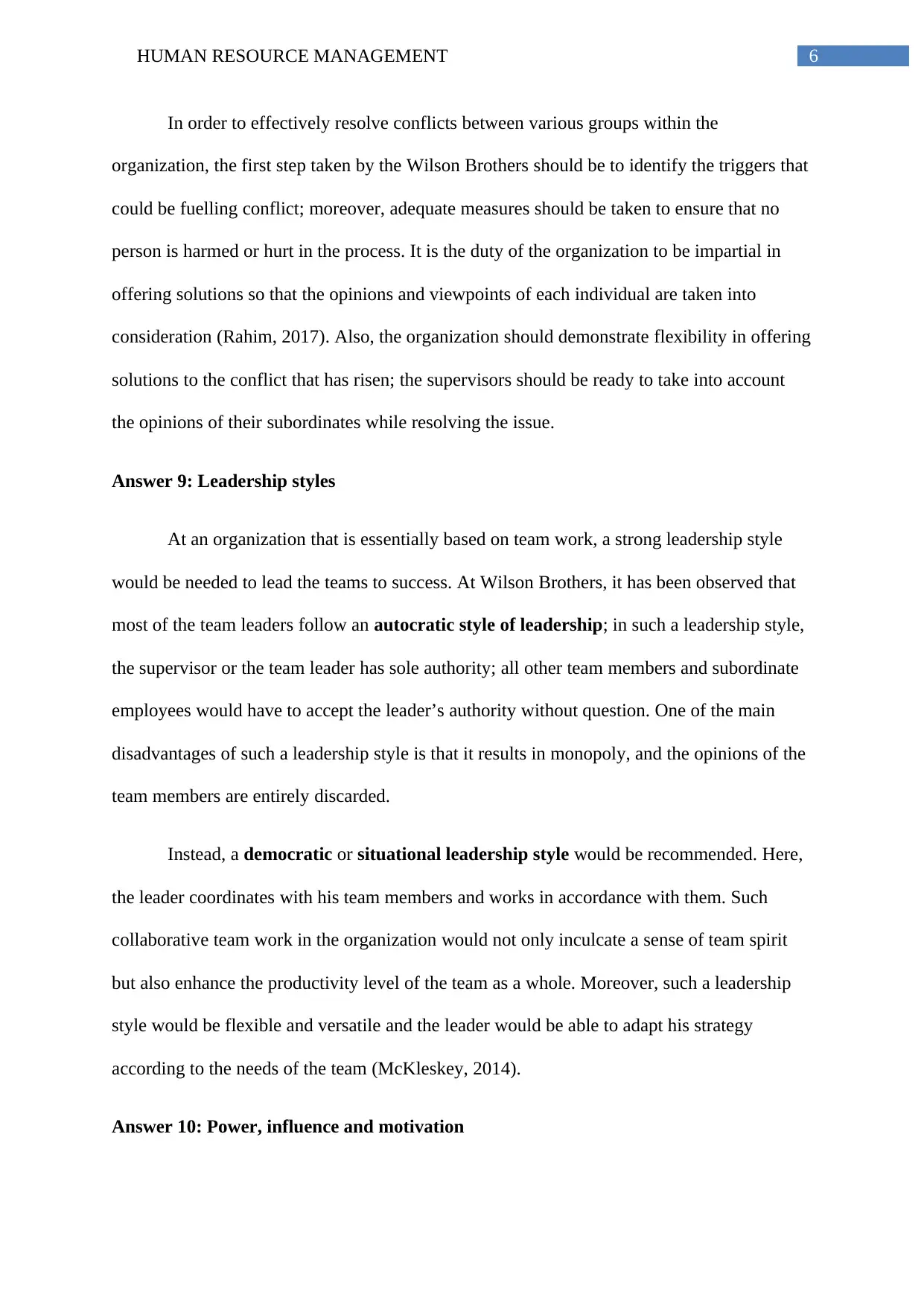
6HUMAN RESOURCE MANAGEMENT
In order to effectively resolve conflicts between various groups within the
organization, the first step taken by the Wilson Brothers should be to identify the triggers that
could be fuelling conflict; moreover, adequate measures should be taken to ensure that no
person is harmed or hurt in the process. It is the duty of the organization to be impartial in
offering solutions so that the opinions and viewpoints of each individual are taken into
consideration (Rahim, 2017). Also, the organization should demonstrate flexibility in offering
solutions to the conflict that has risen; the supervisors should be ready to take into account
the opinions of their subordinates while resolving the issue.
Answer 9: Leadership styles
At an organization that is essentially based on team work, a strong leadership style
would be needed to lead the teams to success. At Wilson Brothers, it has been observed that
most of the team leaders follow an autocratic style of leadership; in such a leadership style,
the supervisor or the team leader has sole authority; all other team members and subordinate
employees would have to accept the leader’s authority without question. One of the main
disadvantages of such a leadership style is that it results in monopoly, and the opinions of the
team members are entirely discarded.
Instead, a democratic or situational leadership style would be recommended. Here,
the leader coordinates with his team members and works in accordance with them. Such
collaborative team work in the organization would not only inculcate a sense of team spirit
but also enhance the productivity level of the team as a whole. Moreover, such a leadership
style would be flexible and versatile and the leader would be able to adapt his strategy
according to the needs of the team (McKleskey, 2014).
Answer 10: Power, influence and motivation
In order to effectively resolve conflicts between various groups within the
organization, the first step taken by the Wilson Brothers should be to identify the triggers that
could be fuelling conflict; moreover, adequate measures should be taken to ensure that no
person is harmed or hurt in the process. It is the duty of the organization to be impartial in
offering solutions so that the opinions and viewpoints of each individual are taken into
consideration (Rahim, 2017). Also, the organization should demonstrate flexibility in offering
solutions to the conflict that has risen; the supervisors should be ready to take into account
the opinions of their subordinates while resolving the issue.
Answer 9: Leadership styles
At an organization that is essentially based on team work, a strong leadership style
would be needed to lead the teams to success. At Wilson Brothers, it has been observed that
most of the team leaders follow an autocratic style of leadership; in such a leadership style,
the supervisor or the team leader has sole authority; all other team members and subordinate
employees would have to accept the leader’s authority without question. One of the main
disadvantages of such a leadership style is that it results in monopoly, and the opinions of the
team members are entirely discarded.
Instead, a democratic or situational leadership style would be recommended. Here,
the leader coordinates with his team members and works in accordance with them. Such
collaborative team work in the organization would not only inculcate a sense of team spirit
but also enhance the productivity level of the team as a whole. Moreover, such a leadership
style would be flexible and versatile and the leader would be able to adapt his strategy
according to the needs of the team (McKleskey, 2014).
Answer 10: Power, influence and motivation
Paraphrase This Document
Need a fresh take? Get an instant paraphrase of this document with our AI Paraphraser
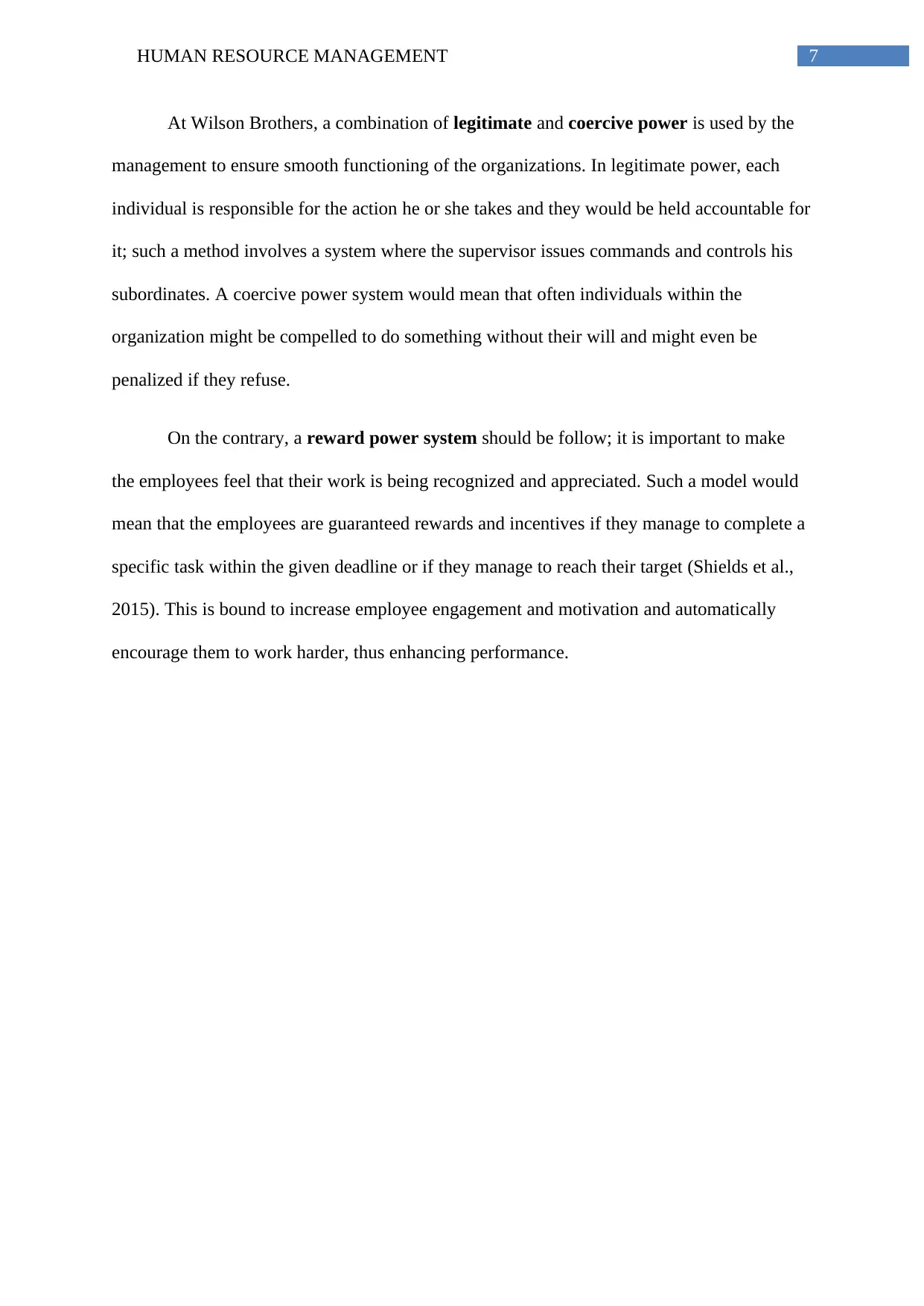
7HUMAN RESOURCE MANAGEMENT
At Wilson Brothers, a combination of legitimate and coercive power is used by the
management to ensure smooth functioning of the organizations. In legitimate power, each
individual is responsible for the action he or she takes and they would be held accountable for
it; such a method involves a system where the supervisor issues commands and controls his
subordinates. A coercive power system would mean that often individuals within the
organization might be compelled to do something without their will and might even be
penalized if they refuse.
On the contrary, a reward power system should be follow; it is important to make
the employees feel that their work is being recognized and appreciated. Such a model would
mean that the employees are guaranteed rewards and incentives if they manage to complete a
specific task within the given deadline or if they manage to reach their target (Shields et al.,
2015). This is bound to increase employee engagement and motivation and automatically
encourage them to work harder, thus enhancing performance.
At Wilson Brothers, a combination of legitimate and coercive power is used by the
management to ensure smooth functioning of the organizations. In legitimate power, each
individual is responsible for the action he or she takes and they would be held accountable for
it; such a method involves a system where the supervisor issues commands and controls his
subordinates. A coercive power system would mean that often individuals within the
organization might be compelled to do something without their will and might even be
penalized if they refuse.
On the contrary, a reward power system should be follow; it is important to make
the employees feel that their work is being recognized and appreciated. Such a model would
mean that the employees are guaranteed rewards and incentives if they manage to complete a
specific task within the given deadline or if they manage to reach their target (Shields et al.,
2015). This is bound to increase employee engagement and motivation and automatically
encourage them to work harder, thus enhancing performance.
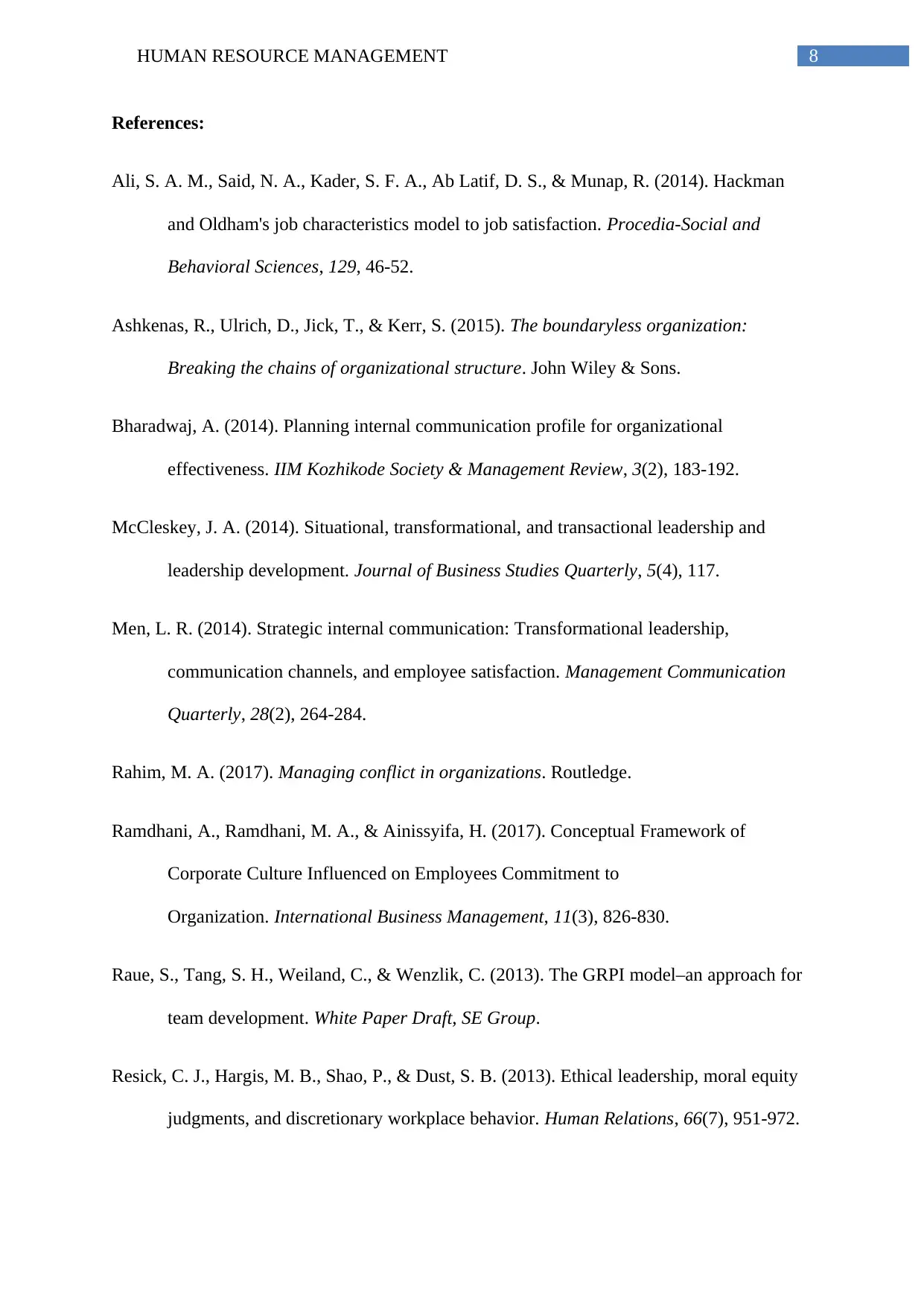
8HUMAN RESOURCE MANAGEMENT
References:
Ali, S. A. M., Said, N. A., Kader, S. F. A., Ab Latif, D. S., & Munap, R. (2014). Hackman
and Oldham's job characteristics model to job satisfaction. Procedia-Social and
Behavioral Sciences, 129, 46-52.
Ashkenas, R., Ulrich, D., Jick, T., & Kerr, S. (2015). The boundaryless organization:
Breaking the chains of organizational structure. John Wiley & Sons.
Bharadwaj, A. (2014). Planning internal communication profile for organizational
effectiveness. IIM Kozhikode Society & Management Review, 3(2), 183-192.
McCleskey, J. A. (2014). Situational, transformational, and transactional leadership and
leadership development. Journal of Business Studies Quarterly, 5(4), 117.
Men, L. R. (2014). Strategic internal communication: Transformational leadership,
communication channels, and employee satisfaction. Management Communication
Quarterly, 28(2), 264-284.
Rahim, M. A. (2017). Managing conflict in organizations. Routledge.
Ramdhani, A., Ramdhani, M. A., & Ainissyifa, H. (2017). Conceptual Framework of
Corporate Culture Influenced on Employees Commitment to
Organization. International Business Management, 11(3), 826-830.
Raue, S., Tang, S. H., Weiland, C., & Wenzlik, C. (2013). The GRPI model–an approach for
team development. White Paper Draft, SE Group.
Resick, C. J., Hargis, M. B., Shao, P., & Dust, S. B. (2013). Ethical leadership, moral equity
judgments, and discretionary workplace behavior. Human Relations, 66(7), 951-972.
References:
Ali, S. A. M., Said, N. A., Kader, S. F. A., Ab Latif, D. S., & Munap, R. (2014). Hackman
and Oldham's job characteristics model to job satisfaction. Procedia-Social and
Behavioral Sciences, 129, 46-52.
Ashkenas, R., Ulrich, D., Jick, T., & Kerr, S. (2015). The boundaryless organization:
Breaking the chains of organizational structure. John Wiley & Sons.
Bharadwaj, A. (2014). Planning internal communication profile for organizational
effectiveness. IIM Kozhikode Society & Management Review, 3(2), 183-192.
McCleskey, J. A. (2014). Situational, transformational, and transactional leadership and
leadership development. Journal of Business Studies Quarterly, 5(4), 117.
Men, L. R. (2014). Strategic internal communication: Transformational leadership,
communication channels, and employee satisfaction. Management Communication
Quarterly, 28(2), 264-284.
Rahim, M. A. (2017). Managing conflict in organizations. Routledge.
Ramdhani, A., Ramdhani, M. A., & Ainissyifa, H. (2017). Conceptual Framework of
Corporate Culture Influenced on Employees Commitment to
Organization. International Business Management, 11(3), 826-830.
Raue, S., Tang, S. H., Weiland, C., & Wenzlik, C. (2013). The GRPI model–an approach for
team development. White Paper Draft, SE Group.
Resick, C. J., Hargis, M. B., Shao, P., & Dust, S. B. (2013). Ethical leadership, moral equity
judgments, and discretionary workplace behavior. Human Relations, 66(7), 951-972.
⊘ This is a preview!⊘
Do you want full access?
Subscribe today to unlock all pages.

Trusted by 1+ million students worldwide
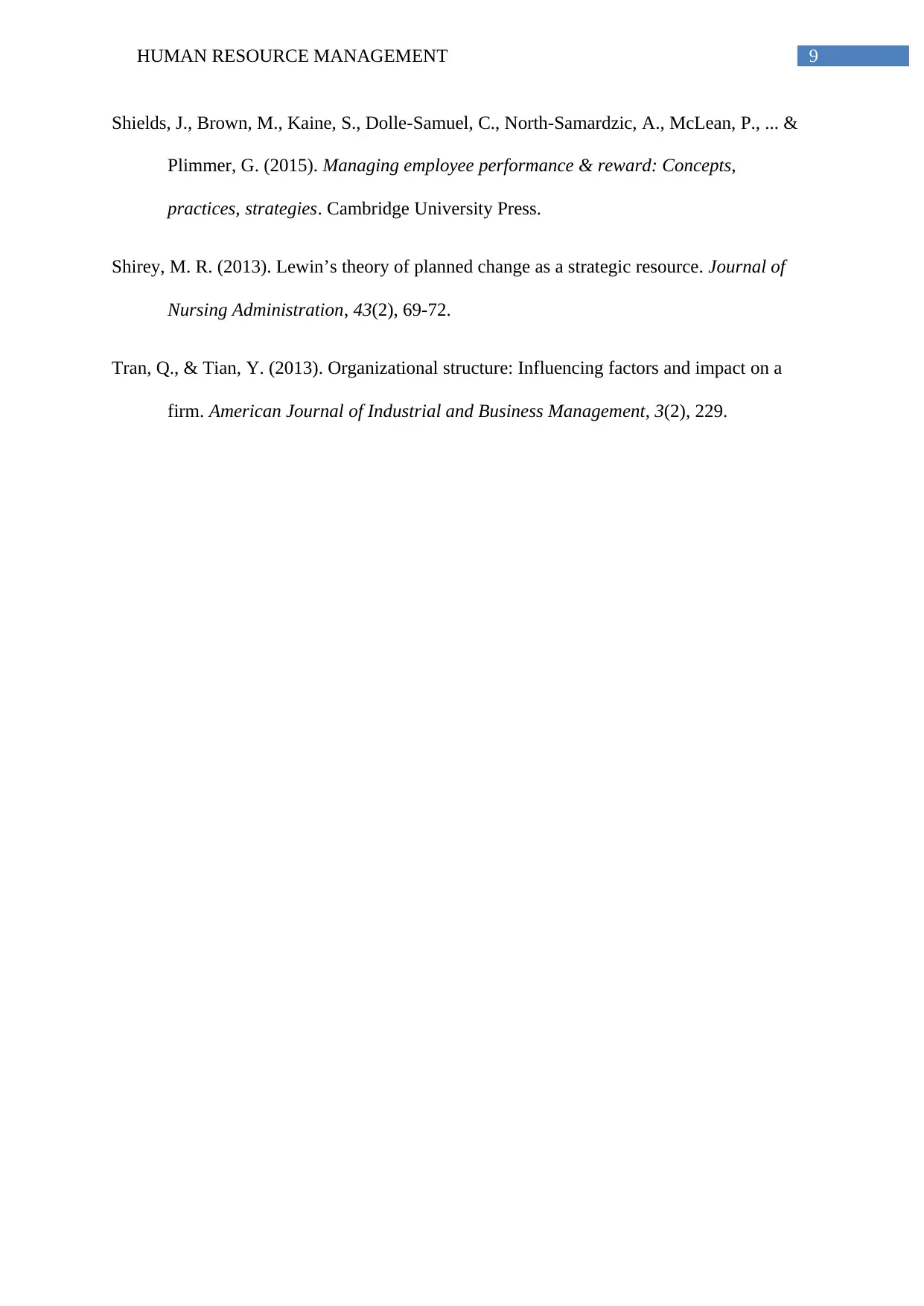
9HUMAN RESOURCE MANAGEMENT
Shields, J., Brown, M., Kaine, S., Dolle-Samuel, C., North-Samardzic, A., McLean, P., ... &
Plimmer, G. (2015). Managing employee performance & reward: Concepts,
practices, strategies. Cambridge University Press.
Shirey, M. R. (2013). Lewin’s theory of planned change as a strategic resource. Journal of
Nursing Administration, 43(2), 69-72.
Tran, Q., & Tian, Y. (2013). Organizational structure: Influencing factors and impact on a
firm. American Journal of Industrial and Business Management, 3(2), 229.
Shields, J., Brown, M., Kaine, S., Dolle-Samuel, C., North-Samardzic, A., McLean, P., ... &
Plimmer, G. (2015). Managing employee performance & reward: Concepts,
practices, strategies. Cambridge University Press.
Shirey, M. R. (2013). Lewin’s theory of planned change as a strategic resource. Journal of
Nursing Administration, 43(2), 69-72.
Tran, Q., & Tian, Y. (2013). Organizational structure: Influencing factors and impact on a
firm. American Journal of Industrial and Business Management, 3(2), 229.
1 out of 10
Related Documents
Your All-in-One AI-Powered Toolkit for Academic Success.
+13062052269
info@desklib.com
Available 24*7 on WhatsApp / Email
![[object Object]](/_next/static/media/star-bottom.7253800d.svg)
Unlock your academic potential
Copyright © 2020–2025 A2Z Services. All Rights Reserved. Developed and managed by ZUCOL.





